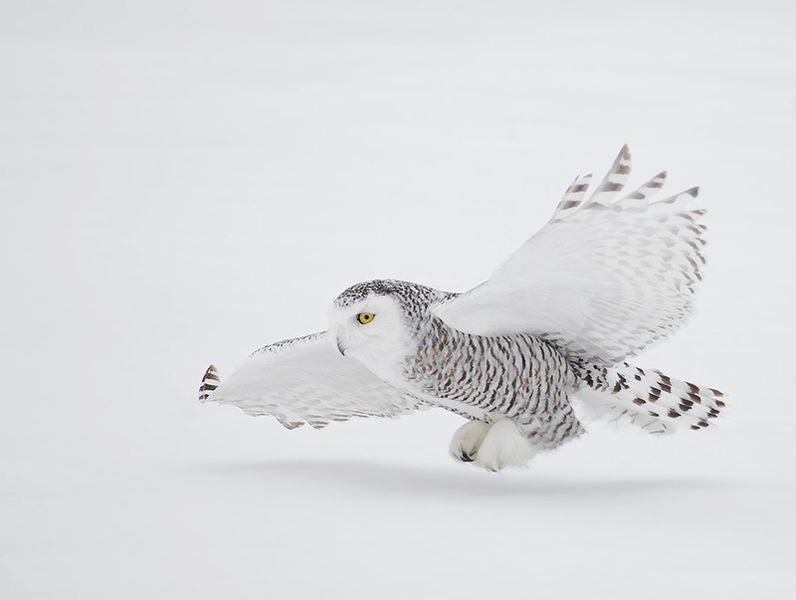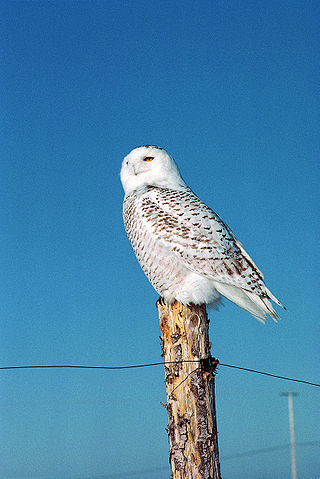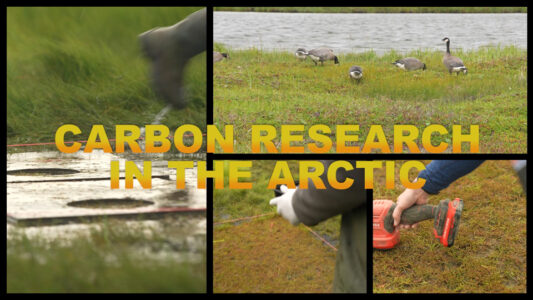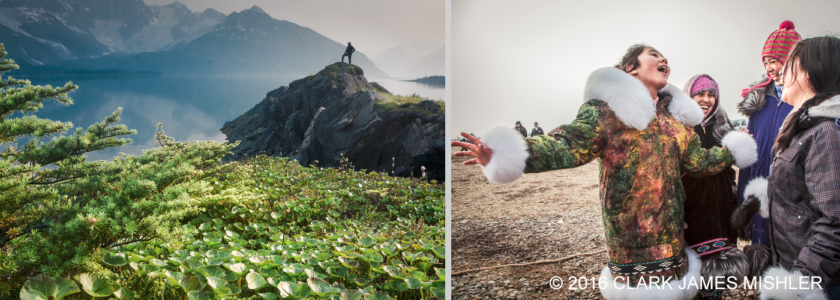
Quebec, Ontario (Creative Commons Attribution-Share Alike 3.0 Unported license)
Laura Nielsen for Frontier Scientists –
This winter snowy owls were on the move; unusually large numbers of the magnificent birds made their way to the Lower 48 United States. With a wing span greater than four feet and distinctive plumage, snowy owls are a glorious sight. The birds’ winter migrations normally take them to Canada’s southern provinces. Some birds come all the way to the northern U.S. – especially near the coasts. Yet this year snowy owls winged their way southward all the way to North Carolina, Florida, and even Bermuda!
Irruption
The influx of migrating owls, which caused a sharp increase in snowy owl population numbers noted in the south, is called an irruption. This irruption (referred to as the 2013 invasion because the winter season began in 2013) brought numerous snowy owls to the Lower 48, with birdwatchers recording sightings especially in the Northeast states, along the Atlantic coast, and around the Great Lakes.
2011 also saw an impressive snowy owl irruption, with sightings more concentrated in the Great Plains states.
Snowy owls are opportunistic predators; they’ll eat almost anything. Small rodents, waterfowl, and migrating birds are favored prey. The owls like to hunt in areas that resemble the open tundra of their normal Arctic habitat – you can often find them in open fields, near extensive marshes, and near wide beachfronts.
An unusual number of visiting snowy owls is a treat for birdwatchers but a headache for airports. At Boston’s Logan International Airport Nornam Smith, the director of Mass Audubon Blue Hills Trailside Museum in Lincoln, Massachusetts, trapped 85 snowy owls just this winter. The birds’ predisposition to hunt in wide open spaces at airports means they pose a risk to airplane engines.
What caused this winter’s snowy owl invasion?
Snowy owl irruptions probably occur after an abundance of prey causes a population boom among the owls. Lots of available food promotes a highly productive breeding season and results in unusually high numbers of young owls.
Research suggests that snowy owls fly long distances in search of sites with adequate hunting opportunities before they nest. If prey is abundant they can lay up to nine eggs and raise healthy, fat chicks. If prey is scarce, the owls may not nest or lay eggs at all.

In 2013’s nesting season, far to the north on Bylot Island in Canada’s Nunavut Territory, prey was so abundant that many snowy owl pairs raised large broods of chicks. They fed them on lemmings – small Arctic rodents about the size of hamsters. The Eastern Canadian Arctic proved a great place to raise chicks.
When the cold season comes, winter snows hide lemmings; the small rodents dig tunnels and burrows in the snowpack. It takes skill to catch the hidden animals, and only so many hunters can be supported by the number of prey available in the Arctic over the winter. That means that many young snowy owls leave the area. After hatching, snowy owl chicks can fly within two months’ time. The abundance of owls we’re seeing this cold season, especially toward the eastern half of the continent, is probably due to young adult owls fed on the abundance of warm-season prey in eastern Canada. The owls spread out to search for winter-season hunting opportunities.
Snowy owls that ornithologists have spotted in the south are young, but fat and healthy. It is probable that they will hunt successfully and return to the Arctic sometime this spring as more skilled hunters.
There are a lot of caveats involved when I talk about Arctic birds. The far north reaches of our globe are remote and often harsh. We can’t set aside the Arctic when we study Earth and its creatures; if we support observation networks and scientific studies in the Arctic, the knowledge gained will help us understand Earth’s systems. Everything is interconnected.
Tagging and tracking
This winter’s unusual irruption has given researchers a good opportunity to trap wide-wandering snowy owls and outfit them with solar-powered GPS transmitters. The transmitters, worn like tiny backpacks, send back information about their owl’s position, altitude, and speed.
Project Snowstorm’s mission will record much-needed information about snowy owls. The mission and the technicalities of tagging owls were covered by National Public Radio.
Another way that snowy owls are being tracked is via eBird, an online hub created by Cornell University’s Department of Ornithology and the National Audubon Society. eBird lets bird spotters report in, and compiles reports into interactive online maps. The website records this about snowy owls:
“One of the main goals of eBird is to track bird populations to better understand the world around us. Movements and populations of birds represent a great way to monitor the pulse of ecosystem health.” … “It could be that this is a large invasion that is part of periodic and natural fluctuations; or an unsettled Arctic environment could be part of the story.” … “Although these invasions have been happening for centuries, a warming Arctic is likely to be affecting the exact dynamics. How warmer summers and increased snowfall affect summer lemming cycles, Snowy Owl cycles, winter prey availability, and complex interactions between these factors is still poorly known.”
Arctic amplification
Henry Tepper, the president of Mass Audubon, stated “Think about the canary in the coal mine,” and “you think about the snowy owl in the Arctic.” When the birds’ patterns are unusual, as they are this winter, it might be telling us something about their home habitat.”
Snowy owls are majestic, charismatic birds. Yet their existence depends on a complex web of life with much less showy inhabitants, like the unassuming lemming. Snowy owls showing up in Florida might tell us something – it might prompt us to turn our eyes North.
On average, the Arctic is warming two times faster than any other region of the world. It’s a phenomenon called Arctic amplification, and it has implications for not only the far North but also for the contiguous United States and abroad. Amplified Arctic warming is contributing to more frequent and more extreme weather events in North America and Europe.
The patterns of lemmings
Predator and prey populations in the Arctic have been historically observed to be cyclical. Lemming populations tend to spike every four years. Yet lemmings thrive best under certain living conditions… conditions which may be changing.

Lemmings thrive when they eat grass and sedge. It is interesting to note that grass and sedge also thrive when lemming populations are present. One study near Barrow, Alaska, excluded lemmings from plots of land for 50 years to discover which plants would dominate in a habitat devoid of lemmings. Within these fenced-off areas, lichens and bryophytes (i.e. mosses) grew best, and grass and sedge suffered. In contrast the areas where lemmings were allowed to graze had a dominant healthy population of grass and sedge, even though the lemmings kept nibbling at them. Yet Arctic plant populations are changing. As temperatures warm, plant communities are pushing northward, growing best in the conditions which each species’ physiology favors. That means that communities of grass and sedge in places lemmings congregate are being overtaken by short willows and shrubs – competitor species. Climate change is slowly altering where lemmings can find their favored foods.
Lemmings den in subniveal (under snow) spaces, digging their way through the snowpack, tunneling and burrowing. The small creatures spend nine months of the year under the snow, raising litters and digging down to the ground to eat low-lying plants encased in snow; the snowpack is incredibly important to them as a habitat. There they raise litters of six to eight. Lemmings mature swiftly, and up to three generations might be born in the same winter.
Yet the Arctic is changing swiftly, and as its climate grows milder there are consequences. Warmer conditions create less stable snowpacks. The crunchy ice crystals that lemmings normally dig through can melt unexpectedly in high temperatures, flooding tunnels. Then at night it might freeze again, making a solid icy layer over plants, a thick layer that lemmings cannot dig through. In Scandinavia and Greenland lemming populations have not been following historic four-year patterns. In fact populations there haven’t peaked in over a decade. Happily for the owls, Canada’s environmental conditions have continued to allow lemmings to flourish in their normal four-year patterns.
I can’t speak to the future of the lemmings with any certainty. Rick Thoman, climate science and service manager for the National Weather Service, Alaska region, reminds us that weather variability means that even as climate warms, cold-temperature conditions will still manifest. We need to use real, long-term data in order to increase our understanding of climate.
“If you get a high pressure that remains parked over the western Bering sea and keeps Northerly winds going, it’s going to be cool over mainland Alaska. But it doesn’t really tells us anything about changes in climate because climate by definition is very long – several decades, period. [If] you want to talk about climate change, you have to look at all of the seasons over those several decades to be able to make statements. … What we have to look at is changes in the frequency, duration of cold spells over decades.”

Significant long-term warming
When we look toward future warming, we use global-average surface air temperatures because that’s the most abundant network we have in place for climate measurements. Yet it’s not enough to examine surface air temperatures alone. The planet is a complex system. The oceans, for example, are mighty heat sinks. Matt England, deputy director of the Climate Change Research Center at the University of New South Wales, talks about the problem: “Any slowdown in the overall temperature trend sees lobby groups falsely claim that global warming is over. Never mind that the globe – our planet – spans the oceans, atmosphere, land and ice systems in their entirety.”
The warming of global-average surface air temperatures has slowed. According to NASA:
“Global temperatures have increased at a rate of 0.22 Fahrenheit (0.12 Celsius) per decade since 1951. But since 1998, the rate of warming has been only 0.09 F (0.05 C) per decade — even as atmospheric carbon dioxide continues to rise at a rate similar to previous decades.” And “The Fifth Assessment Report of the Intergovernmental Panel on Climate Change (IPCC), which was issued in 2013 and was the consensus report on the state of climate change science,” [therefore] “reduced the lower range of Earth’s potential for global warming.”
Yet new research that fine-tunes climate models takes more than just surface air temperatures into account. We’re learning more and more about how the oceans and atmosphere are coupled. We’re also recognizing the importance of aerosols, tiny airborne particles that have an immense impact on driving climate change. A new study by Drew Shindell, ozone specialist and climatologist at the NASA Goddard Institute for Space Studies, was recently published in the journal Nature Climate Change. Shindell recalculated Earth’s climate sensitivity while taking aerosol factors into account. Shindell’s work reaffirms that Earth is just as sensitive to greenhouse gas increases as previously thought.
The Northern Hemisphere has a disproportionate influence on measurable warming. It holds more landmasses while the Southern Hemisphere holds more oceans. The effects of warming are displayed more swiftly on land and surface ice than over the immense oceans. Man-made aerosols and pollutants released by heavily industrialized Northern nations can land on surfaces and darken them, trapping more energy from the Sun. At the same time, airborne aerosols introduce great complexity: some soak up energy and promote warming, some help form reflective clouds and promote cooling.
Shindell’s work has refined our understanding of how aerosols drive climate change, leading to more accurate climate modeling. NASA reported on Shindell’s results:
“Shindell’s climate sensitivity calculation suggests countries around the world need to reduce greenhouse gas emissions at the higher end of proposed emissions reduction ranges to avoid the most damaging consequences of climate change. “I wish it weren’t so,” said Shindell, “but forewarned is forearmed.””
Snowy owls in a changing world
The young snowy owls that were with us this cold season flew south incredible distances. A round-trip from north of the Arctic Circle to Boston and back is over 7,000 miles [11,000 kilometers]. After they return to the Arctic, they are likely to traverse more than 620 miles [1,000 kilometers] during the short summer seeking prey. Data transmitted by the tiny backpacks worn by newly tagged snowy owls will help us learn still more about the mysterious Arctic birds, and our planet’s ever-changing conditions.
LINKS
Find snowy owls using eBird: http://ebird.org/content/ebird/news/gotsnowies2013/
Watch: Audubon CBC-IrruptiveSpecies@BobSacha from Audubon Science on Vimeo.
Frontier Scientists: presenting scientific discovery in the Arctic and beyond
References:
- ‘A Bird Flies South, and It’s News’ John Schwartzjan, The New York Times (Jan 31, 2014)
http://www.nytimes.com/2014/02/01/us/influx-of-snowy-owls-thrills-and-baffles-birders.html - ‘A snowy-owl bonanza, thanks to a little, stubby-legged Arctic rodent: The lemming’ Darryl Fears, The Washington Post Health & Science (February 16, 2014)
http://www.washingtonpost.com/national/health-science/a-snowy-owl-bonanza-thanks-to-a-little-stubby-legged-arctic-rodent-the-lemming/2014/02/16/57c08cfe-94c9-11e3-83b9-1f024193bb84_story.html - ‘Arctic wanderers–Snowy Owl invasion 2013’ eBird Latest News © Audubon and Cornell Lab of Ornithology (December 11, 2013)
http://ebird.org/content/ebird/news/gotsnowies2013/ - ‘Could lemmings be involved in regulating our climate?’ IOP Institute of Physics News (November 18, 2011)
http://www.iop.org/news/11/nov/page_52829.html - ‘Exclusion of brown lemmings reduces vascular plant cover and biomass in arctic coastal tundra’ D R Johnson, M J Lara, G R Shaver, G O Batzli, J D Shaw and C E Tweedie, IOP Science Environmental Research Letters 6 (October-December 2011) 045507 doi:10.1088/1748-9326/6/4/045507 (November 17, 2011)
http://iopscience.iop.org/1748-9326/6/4/045507/fulltext/ - ‘Going with the wind’ Matthew England, guest post on RealClimate (February 17, 2014)
http://www.realclimate.org/index.php/archives/2014/02/going-with-the-wind/ - ‘Inhomogeneous forcing and transient climate sensitivity’ Drew T. Shindell, Nature Climate Change 4 , 274–277 (2014) doi:10.1038/nclimate2136 (March 9, 2014)
http://www.nature.com/nclimate/journal/v4/n4/full/nclimate2136.html - ‘Irruption: When the messenger comes to us’ GrrlScientist on theguardian.com (March 8, 2014)
http://www.theguardian.com/science/grrlscientist/2014/mar/08/irruption-snowy-owls-video - ‘Long-Term Warming Likely to Be Significant Despite Recent Slowdown’ NASA News Release (March 11, 2014)
http://www.nasa.gov/press/2014/march/long-term-warming-likely-to-be-significant-despite-recent-slowdown/#.UzjOivldV8F - ‘Trapping And Tracking The Mysterious Snowy Owl’ Adam Cole & Meredith Rizzo, National Public Radio News Science (March 11, 2014)
http://www.npr.org/2014/03/11/288762497/the-great-snowy-owl-invasion














